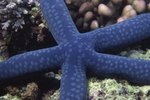
The ammonia or nitrogen cycle keeps aquarium fish alive. Breaking in this cycle entails establishing colonies of various bacteria that turn ammonia into less toxic nitrite, then nitrate. The traditional method of cycling involves using a few hardy aquarium fish to kick off the process, then slowly adding fish until the tank is fully stocked.
Step 1
Calculate the capacity of your aquarium. Typically, guidelines for stocking a tank are based on the size of the fish and the volume of your aquarium. For tropical freshwater tanks, budget one gallon of the tank's capacity per inch of aquarium fish. In saltwater tanks, use about half of that, so one inch of fish per two gallons of volume.
Step 2
Add your first fish. Do not add more than half of your aquarium's capacity in fish-inches in this first batch of fish. Ideally, add only a few fish to get started.
Step 3
Measure ammonia and nitrite daily. You will see ammonia rise, then peak and decline. As ammonia declines, nitrite will follow a similar pattern. Within a few weeks, both ammonia and nitrite should reach undetectable levels.
Step 4
Perform a 25 percent water change once the ammonia and nitrite levels both reach zero. Then add the next small batch of fish. Repeat this process until you have stocked your aquarium to capacity.
Step 5
Avoid any sources of excess ammonia, which can tax the cycling process. Avoid overfeeding, remove dead fish and plants right away, maintain the proper aquarium temperature and provide sufficient water movement. Cycling bacteria live most comfortably at 77 to 86 degrees Fahrenheit and a pH between 7.5 to 8.
References
Tips
- Make sure the first fish are the hardiest.
- Aquarium plants can speed the cycling process, but only if you take good care of them. Aquarium plants are harder to take care of than they look.
- Add territorial fish last, so they don't consider the entire tank "mine."
- You can speed cycling by adding decorations or gravel from an established aquarium.
- Do not rush this process. It may take a few weeks or more, depending on the size of the tank and the number of fish.
Warnings
- For delicate species, consider fishless cycling. This process requires more research and patience than traditional cycling, but does not expose fish to ammonia or nitrite spikes.
- The stocking guidelines break down on fish longer than 3 inches, so research your specific species if you want to keep larger fish.
Photo Credits
-
Comstock Images/Comstock/Getty Images




